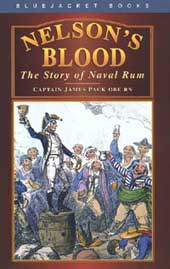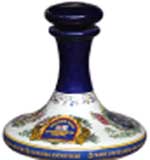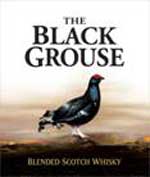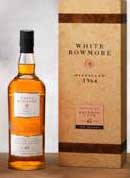|
NELSON'S BLOOD HELPED BRITAIN RULE THE WAVES
A Rum do brought the flavour of the Caribbean to  central London as autumn leaves began to fall. The pirates’ favourite poison was here to capture new fans and renew old acquaintances. central London as autumn leaves began to fall. The pirates’ favourite poison was here to capture new fans and renew old acquaintances.
One of its oldest acquaintances was the Royal Navy, of course. When it took over the pirates’ nest of Jamaica in 1655, it captured a ready supply of the drink being distilled on the sugarcane plantations, and it seemed practical to switch the daily ration for sailors from brandy to rum. Served neat, in half pint measures, twice a day, it clearly helped Britain rule the waves.
The authentic Navy rum for over 300 years was Pusser’s, issued through the ship’s Purser – hence the name. Also known as Nelson’s Blood,  tradition has it that Nelson’s body was preserved in a barrel of the stuff after the battle of Trafalgar. But when the ship reached port, the barrel was dry, the sailors having drunk the contents - Nelson's Blood. The Admiral, it may be tradition has it that Nelson’s body was preserved in a barrel of the stuff after the battle of Trafalgar. But when the ship reached port, the barrel was dry, the sailors having drunk the contents - Nelson's Blood. The Admiral, it may be  assumed, remained pickled. assumed, remained pickled.
Admiral Edward Vernon was the spoilsport who began the practice of watering the generous rations down, around 1740, when it became known as ‘grog’. And a daily ‘tot’ continued to be served until 1970, when it was banished - an act commemorated in the Navy as Black Tot Day.
This book provides an enjoyable history of the Navy, and its rum traditions, available on Amazon.
After the daily ration was vetoed, Pusser's rum disappeared but was resurrected by keen sailor, Charles Tobias, some ten years later. He obtained the rights and blending details of the Royal Navy's rum  specification to make his Pusser's Rum the authentic Navy version. It has gone on to take gold medals at various drinks festivals, has a 54.5per cent ABV, and royalties from the retail price to the Royal Navy Sailors' Fund have so far contributed £750,000. specification to make his Pusser's Rum the authentic Navy version. It has gone on to take gold medals at various drinks festivals, has a 54.5per cent ABV, and royalties from the retail price to the Royal Navy Sailors' Fund have so far contributed £750,000.
Bottle of Pusser's above retails at around £25, or the ceramic ship's decanter here, commemorating Trafalgar Day, is priced at £57. A tot is offered from the grog barrel at top.
Today, rum comes in a wide variety of tastes and brands, a far cry from the dangerous brews that fortified the 17th century sailors. At the Rum Fest event staged in London, there were white and pale, dark and black, delicate flavours and heavily spiced rums, many from outside the Caribbean region.
White and clear versions are generally rated best for use in cocktails, as they are not too strongly flavoured. Pale and Golden rums indicate the mellowing process in the barrels, still good for cocktails but also served neat or on the rocks. The dark or black rums are perhaps nearest to the strong liquor that the pirates would have drunk, rich and full bodied, as in Whaler’s Dark and Cruzan Black Strap. Some might have knocked Blackbeard over – up to 169 proof in Sunset Very Strong Rum, with the warning “offers a surprisingly powerful experience”. Used for long cocktails, punches and cooking flambé. Cream liqueurs and spiced, fruity rums cater for those with a sweet taste, notably the Charbay Tahitian Vanilla Bean Rum, a syrupy concoction from California.
For further information on rums of all sorts go to www.giftedrums.com
SCOTCH DRINKERS TO BIRD RESCUE
 Save the bird and drink up your whisky. The bird in question is of the feathered variety and the whisky the Black Grouse. Save the bird and drink up your whisky. The bird in question is of the feathered variety and the whisky the Black Grouse.
This blend of The Famous Grouse with added Islay malts to create a rich smoky, peaty taste won a Gold medal in the Whisky section of the International Spirits Challenge – one of many Gold medalists, we should point out. But this is the only one, so far as we know, to be donating 50p from every bottle sold to the Royal Society for the Protection of Birds to help save its namesake from extinction.
The black grouse is now on the UK Red List of conservation species, as a result of a massive decline in its numbers. This is largely due to a loss and degradation of its native habitat. Conifer plantations are not good for black grouse, nor deer fences. They like to live on the edge of woodlands, next to moorlands, where they may feed and roost in safety. The RSPB is working to help provide such conditions for these and other birds – and with the help of Black Grouse drinkers will save them from extinction.
Launched in April of this year, it is on sale in licensed premises and in Sainsbury’s at £15.49, and goes on general retail release in January.
LATEST MALT IN LEGENDARY SERIES
£2,500 is the price for a 43 year old single malt whisky, the latest launch from the Bowmore Distillery.
 White Bowmore follows last year's 42 year old Black Bowmore, and has been gradually maturing in six bourbon casks in the distillery’s No 1 vaults since 1964. A collector’s item for whisky connoisseurs throughout the world, it is the second of three limited edition colour releases, each bottle individually numbered by hand and presented in a classic Maple cabinet. White Bowmore follows last year's 42 year old Black Bowmore, and has been gradually maturing in six bourbon casks in the distillery’s No 1 vaults since 1964. A collector’s item for whisky connoisseurs throughout the world, it is the second of three limited edition colour releases, each bottle individually numbered by hand and presented in a classic Maple cabinet.
With only 732 bottles released, interest is expected to be high. A bottle of Bowmore from the 1800’s recently sold at auction for £29,400. The third edition is not expected until the end of next year.
|